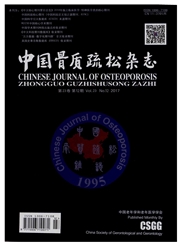

 中文摘要:
中文摘要:
目的研究人工虎骨粉对大鼠骨折愈合的影响。方法SPF级成年健康SD大鼠72只,麻醉状态下制作右侧胫中段骨折模型,模型制作完成后随机分为实验组和对照组,实验组术后每日灌服人工虎骨粉混悬液,对照组每日灌服蒸馏水。术后2周、4周、2月、3月分别进行影像学观察和组织学观察,术后2月、3月分别进行骨折侧生物力学测量、健侧生物力学测量,并计算骨折生物力学恢复率。结果影像学检查:术后4周,实验组骨痂形成较对照组更广泛、明显;术后2月,实验组皮质骨形成较对照组多。组织学观察:术后2周,实验组骨痂中软骨细胞较对照组明显多;术后4周,实验组骨小梁数量较多,骨痂改建较好;术后2月,实验组骨折处皮质层较厚度对照组大。生物力学测量:术后2月,骨折侧生物力学和骨折生物力学恢复率对照组分别为2.28±0.41N、40.94±10.55%,实验组分别为3.29±0.68N(P〈0.05)、58.85±11.22%(P〈0.05);术后3月,骨折侧生物力学和骨折生物力学恢复率对照组分别为2.67±0.52N、47.17±13.78%,实验组分别为4.14±0.47N(P〈0.05)(P〈0.05)、62.19±13.45%(P〈0.05)。结论人工虎骨粉具有明显的促进骨折愈合作用,并可有效提高正常骨生物力学强度。
 英文摘要:
英文摘要:
Objective To study the effect of artificial tiger bone on fracture healing in rats. Methods 72 healthy adult SPF level SD rats were middle fractured at the right tibia under anesthesia, and randomly divided into experimental and control groups. The experimental group was fed by artificial tiger bone suspension daily and distilled water for the control group. The histological imagings were observed after 2 weeks, 4 weeks, 2 months and 3 months respectively. The biomechanieal measurements at fracture side and the calculation of the recovery rate were performed after 2 month, 3 months each. Results Imaging: 4 weeks afteroperation,in the experimental group the callus formation is more extensive and obvious than the control group; 2 months postoperative, cortical bone formation in the experimental group more than control group. Histology: 2 weeks postoperative, in the experimental group the cartilage callus cells significantly more than the control group;while the experimental group show more trabecular bone volume and bone callus remodeling is better 4 weeks after operation; after 2 months, the experimental group, the fracture the thickness of cortical layers are better than the control group. Biomechanical measurements: 2 months afteroperation, the fracture mechanics and the recovery rate of the control group are 2. 28±0.41N ,40.94±10. 55% respectly and the experiment group are 3.29±0. 68N(P 〈0. 05) ,58.85±11.22% (P 〈0.05) ; 3 months after operation, the fracture mechanics and the recovery rate of the control group are 2. 67±0. 52N, 47.17±13.78% respectly and the experiment group are4. 14±0. 47N ( P 〈 0. 05 ) ( P 〈 0. 05 ) ,62.19±13, 45% (P 〈 0.05 ). Conclusion The artificial tiger bone has a significant role in promoting fracture healing, and can effectively improve the strength of normal bone biomechanics.
 同期刊论文项目
同期刊论文项目
 同项目期刊论文
同项目期刊论文
 The Electrophysiology Analysis of Biological Conduit Sleeve Bridging Rhesus Monkey Median Nerve Inju
The Electrophysiology Analysis of Biological Conduit Sleeve Bridging Rhesus Monkey Median Nerve Inju The Influence of Brain Injury or Peripheral Nerve Injury on Calcitonin Gene-Related Peptide Concentr
The Influence of Brain Injury or Peripheral Nerve Injury on Calcitonin Gene-Related Peptide Concentr Effects of Hedysari Polysaccharides on Regeneration and Function Recovery Following Peripheral Nerve
Effects of Hedysari Polysaccharides on Regeneration and Function Recovery Following Peripheral Nerve Maximum number of collaterals developed by one axon during peripheral nerve regeneration and the inf
Maximum number of collaterals developed by one axon during peripheral nerve regeneration and the inf Alterations in the expression of ATP-sensitive potassium channel subunit mRNA after acute peripheral
Alterations in the expression of ATP-sensitive potassium channel subunit mRNA after acute peripheral Early spatiotemporal progress of myelinated nerve fiber regenerating through biological chitin condu
Early spatiotemporal progress of myelinated nerve fiber regenerating through biological chitin condu The Histological Analysis of Biological Conduit Sleeve Bridging Rhesus Monkey Median Nerve Injury wi
The Histological Analysis of Biological Conduit Sleeve Bridging Rhesus Monkey Median Nerve Injury wi Influence of Different Distal Nerve Degeneration Period on Peripheral Nerve Collateral Sprouts Regen
Influence of Different Distal Nerve Degeneration Period on Peripheral Nerve Collateral Sprouts Regen 期刊信息
期刊信息
